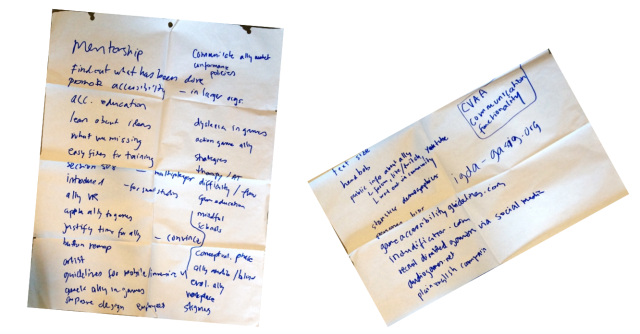When the GA-SIG had the first roundtable at GDC 2004, there was one (1) attendee… who had gone to the wrong room. Fast forward 14 years: there were now more than 50 attendees from the largest players in the industry to independent developers. THANK YOU ALL!
We were thrilled to have 20-30 attendees the last few years but this year took us by storm.

In the roundtable we wanted everyone to say something about their next step (even the first) regarding game accessibility. It took more than 20 minutes just to do that, with me writing notes what was said on posters (pictured below).

People mentioned topics like guidelines, methods, strategies, economy/justify time, social issues, stigmas, organizational issues, accessibility and therapeutic games, and games in education. One of the most common “next step” was simply to start learning or learn more about game accessibility. Starting off the discussion, we focused on some things to begin with for making a game accessible, such as:
- use of simulation goggles etc. for ideation (not validation)
- how to handle colorblindness, text size, and head-bob
- multimodal input and mapping
- having public info about accessibility in the game on forums, Twitch and Youtube
During the discussion, attendees asked for guidelines. The answer was that there are several, where Game Accessibility Guidelines [1] and Includification [2] were suggested to start with. Our Top Ten list [3] is also a good start. Another question concerned how to recruit people with disabilities? Reaching out via social media was suggested, and don’t be afraid of failing, better to do something than nothing. The ‘always with us never without us’ ideal should be followed, but again better to do your best than nothing.
Furthermore, how to write for people with disabilities was also raised. The Plain English Campaign [4] was mentioned. There was also a discussion about return on investment and how to argue for game accessibility. Several reasons were provided, such as legislation (CVAA in the USA, and EAA upcoming in Europe), and statistics and demographics (e.g. about 20% of the world population have a disability, and all gamers are ageing). Further, prototyping with standard/accessible UI elements and then include that as an alternative UI in the game was given as an example to make the game more accessible at almost no cost at all.
We welcome everyone who were at the roundtable (as well as you who read this) to continue the discussion via our mailing list [5]. Please feel free to join!
Best regards,
Thomas Westin
Co-chair
IGDA Game Accessibility SIG
[1] http://gameaccessibilityguidelines.com/
[2] https://www.includification.com/
[3] http://igda-gasig.org/about-game-accessibility/game-accessibility-top-ten/
[4] http://www.plainenglish.co.uk/
[5] http://lists.igda.org/mailman/listinfo/games_access_lists.igda.org

0 comments on “GDC 2018 Roundtable – Session Recap”